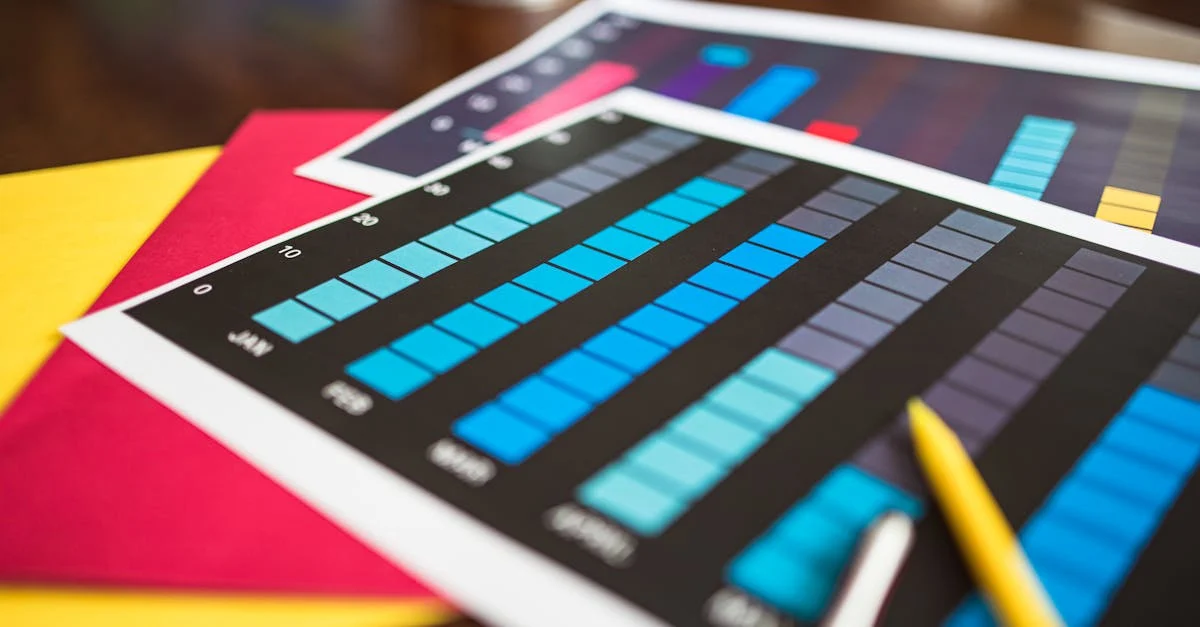Creating visually appealing and informative charts has never been easier thanks to the Chart Tools Design tab in Microsoft Excel. This powerful feature empowers users to transform raw data into professional-looking visualizations with just a few clicks.
The Design tab, which appears automatically when a chart is selected, offers a comprehensive suite of tools for customizing charts. From choosing eye-catching color schemes and layouts to adding chart elements and styles, it’s the go-to destination for anyone looking to enhance their data presentations. Whether someone’s creating a simple bar graph or a complex combination chart, the Chart Tools Design tab streamlines the entire process of chart customization.
Chart Tools Design Tab
The Chart Tools Design tab reveals essential formatting options when a chart is selected in Excel. This specialized ribbon contains a comprehensive set of tools organized into logical groups for efficient chart customization.
Key Elements and Layout
The Chart Tools Design tab organizes its features into five distinct groups: Chart Layouts, Chart Styles, Data, Type & Move Chart. Each group displays related commands with visual icons for quick identification:
- Add Chart Element group contains options for axes titles legends & data labels
- Quick Layout section offers pre-designed chart arrangements
- Colors & Styles group includes theme variations & custom formatting
- Switch Row/Column button transforms data orientation
- Change Chart Type allows seamless conversion between formats
- Chart Styles gallery displays 48 pre-formatted design combinations
- Add Chart Element menu controls individual chart components
- Data Selection tool manages the source range & series
- Type selector features 17 basic chart categories
- Move Chart function enables relocation to new sheets
| Design Tab Group | Available Options | Primary Function |
|---|---|---|
| Chart Layouts | 11 preset layouts | Quick formatting |
| Chart Styles | 48 style variations | Visual themes |
| Data Tools | 4 core functions | Data management |
| Type Options | 17 chart types | Format conversion |
| Move Options | 2 location choices | Chart placement |
Customizing Chart Styles and Colors
The Chart Tools Design tab offers extensive style customization options through its intuitive interface. Users access pre-designed styles with professional color combinations to enhance chart appearance instantly.
Chart Style Gallery Options
The Chart Style gallery displays 48 distinct pre-formatted combinations of colors borders shadows. Each style presents unique formatting variations:
- Quick Style previews show real-time changes when hovering over options
- Built-in styles include modern flat designs monochromatic schemes gradient effects
- Style sets feature coordinated font colors fills borders for visual consistency
- Advanced options modify individual elements like data points chart areas plot regions
- Theme Colors align with document color schemes for brand consistency
- Custom Palettes allow creation of unique color combinations with RGB hex values
- Color Categories separate data series with distinct hues patterns textures
- Sequential Color Schemes show data progression through color intensity variations
| Color Scheme Type | Available Options | Use Case |
|---|---|---|
| Theme Colors | 10 base colors | Document matching |
| Custom Palettes | Unlimited | Brand specific |
| Data Series | 6 default variations | Multiple categories |
| Sequential | 3-9 gradient steps | Numerical progression |
Working with Chart Elements
Chart elements define the visual components that make data meaningful in an Excel chart. The Chart Tools Design tab offers precise control over these elements through dedicated menus.
Adding and Removing Components
The Add Chart Element button in the Chart Layouts group controls the visibility of chart components. Users access a dropdown menu containing 11 primary elements:
- Chart Title: Displays above the plot area
- Axis Titles: Labels for horizontal vertical axes
- Legend: Key identifying data series
- Data Labels: Numerical values on data points
- Gridlines: Reference lines across the plot area
- Trendlines: Statistical trend indicators
- Error Bars: Data variation indicators
- Data Table: Spreadsheet view below the chart
- Axis: Value scales on chart edges
- Plot Area: Main chart drawing region
- Walls Floor: 3D chart background surfaces
- Fill Options: Solid colors gradients patterns
- Border Styles: Line weights dash types colors
- Text Properties: Font size alignment rotation
- Shadow Effects: Offset blur transparency
- 3D Format: Depth contour lighting
- Size Position: Element dimensions location
| Element Type | Available Format Options | Common Applications |
|---|---|---|
| Text Elements | Font, Size, Color, Effects | Titles, Labels, Legend |
| Lines/Borders | Width, Style, Color, Arrows | Axes, Gridlines |
| Shapes/Areas | Fill, Transparency, Patterns | Bars, Plot Area |
| Data Points | Markers, Size, Fill, Borders | Scatter, Line Charts |
Advanced Design Features
The Chart Tools Design tab includes sophisticated features for creating professional-grade visualizations. These advanced options streamline the chart creation process while offering granular control over design elements.
Chart Templates and Presets
Excel’s chart templates preserve customized formatting settings for future use. Users create templates by selecting “Save as Template” in the Change Chart Type dialog box, storing them in the XLTX format. The template library includes:
- Industry-specific templates for finance, sales analytics, project management
- Custom templates with predefined color schemes, fonts, data labels
- Smart templates that automatically adjust based on data types
- Organizational templates ensuring brand consistency
Quick Layouts and Effects
Quick Layouts provide instant access to professional chart arrangements with predefined visual elements. The Effects gallery contains:
| Effect Category | Available Options |
|---|---|
| Shadow Effects | 9 preset options |
| Glow Effects | 6 color variations |
| Soft Edges | 4 size parameters |
| 3D Effects | 12 perspective angles |
| Bevel Styles | 8 depth options |
- One-click layout switching without losing data connections
- Smart guides for precise element positioning
- Dynamic effects that adjust to chart size changes
- Compound effects combining multiple style elements
- Real-time preview functionality for instant visualization
Best Practices for Chart Design
Effective chart design enhances data comprehension through clear visual communication. The Chart Tools Design tab provides features that support implementation of established design principles.
Design Principles for Data Visualization
- Color Selection
- Use contrasting colors for different data series
- Limit color palette to 4-6 colors per chart
- Apply consistent colors across related charts
- Choose colorblind-friendly combinations
- Layout Organization
- Position legends in empty chart areas
- Align text elements horizontally for readability
- Maintain 30% white space around chart elements
- Center titles above the plot area
- Data Representation
- Start numeric axes at zero for bar charts
- Display actual values through data labels
- Group related data points using consistent patterns
- Remove gridlines unless essential for data reading
- Typography Hierarchy
- Set title size 20% larger than axis labels
- Use sans-serif fonts for digital displays
- Maintain consistent font families across elements
- Limit text styles to 2-3 variations
- Text Elements
- Set minimum font size to 10 points
- Provide alt text descriptions for charts
- Use high contrast ratios (4.5:1 minimum)
- Include descriptive chart titles
- Color Usage
- Avoid red-green combinations
- Implement patterns with color differences
- Use solid fills instead of gradients
- Apply distinct tones for critical data points
- Interactive Features
- Enable keyboard navigation
- Add tooltips for data point details
- Create screen reader-compatible labels
- Structure chart elements in logical order
- Format Options
- Apply thick borders around data points
- Use shape markers with color indicators
- Implement strong color contrast for text
- Include direct data labels for key values
| Design Element | Minimum Requirement | Recommended Value |
|---|---|---|
| Font Size | 10pt | 12pt |
| Contrast Ratio | 4.5:1 | 7:1 |
| Color Count | 2 | 4-6 |
| White Space | 20% | 30% |
Data Visualization in Excel
The Chart Tools Design tab transforms Excel charts from basic data visualizations into professional-grade presentations. Its comprehensive suite of tools empowers users to create impactful charts through intuitive customization options and pre-designed templates.
From quick layouts to advanced styling features the Design tab streamlines the chart creation process while maintaining flexibility for detailed customization. Users can efficiently manage chart elements apply professional color schemes and implement design best practices to create compelling data visualizations that effectively communicate their message.
The combination of user-friendly interfaces automated features and precise control options makes the Chart Tools Design tab an invaluable resource for anyone working with data visualization in Excel.



